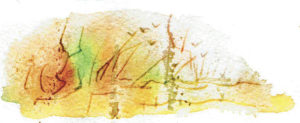Columnists
The lessons of a ditch

I signed up to take on a section of the Millennium Trail for the past weekend for a trash bash in honour of Earth Day. The objective was to gather a crew and together we’d pitch in to clean up what I like to refer to as our 50-kilometre linear park. Our assigned section was the stretch around marker 26, 26 kilometres that is, from the head of the line at Picton.
By early Saturday morning, while an enthusiastic horde of fellow trash-bashers were hard at it up and down the line, and with additional volunteers previously committed, I gladly tackled the designated stretch on my own, appreciating the fact that walking the trail for me is generally a sole and silent meditation. I adopt the Roman saying, Solvitur ambulando— it is solved by walking—and the best thing about the rail corridor is that when you launch into reverie and likely not paying attention to where you are, your feet will stay the course on one of only two choices of directions, making the odds against wandering and getting lost well above average.
 So with abundant daylight and the underbrush barren, now is an optimum time to spot and get at refuse lying in the ditches. Gloves on, garbage and recycling bags in hand, socks pulled over pant legs to ward off ticks, I’m set to go.
So with abundant daylight and the underbrush barren, now is an optimum time to spot and get at refuse lying in the ditches. Gloves on, garbage and recycling bags in hand, socks pulled over pant legs to ward off ticks, I’m set to go.
Westbound in the tranquil light of first of day, while the spring bird migration is still weeks away, I’m kept company by blue jays and goldfinches while chickadees play about my head. Lingering snow clings to north-face shadows while the barking of the crows tell of a season of renewal. Along the way I spot a beer can there, some garbage over here, partially hidden in the grasses and brambles of the ditches, most of it fairly easily accessible.
When about half way along, refuse bags now heavy and me a little dreary, I spot a cluster of cans at the bottom of a steep ditch, a cluster that my conscious mind won’t let me ignore. Wading down-slope into the ravine is when you once again confront Rhamus cathartica head on. The dawning that this bush might become unwelcome and invasive is best said in a North American publication of the early 1800s by an arriving land worker: “…we are accustomed to drawing a large share of horticulture information from a nation much older than ours…in arts and sciences we are taught to believe that the proper answer for hedges, fence rows and windbreaks is the English White Thorn…experience is teaching us that this is in error. The secret lies in the climate.” In error? An understatement! Trust me, if you were ever to hold anyone in contempt, try moving down into a ditch, the home of dense growths of the invasive prickly hawthorn and you’ll soon be cursing your ancestors whether they planted them or not! Go backwards into hawthorn wearing leather is all I can say.
So, now at the bottom of the ditch, I’m at eye level with brittle grasses of surrounding farm fields, flattened and in shaggy-headed recovery from winter. I scan the ground that spreads lazily over acres until interrupted by a border wall of sugar maple over there. In another direction I have a boot’s–eye view of the trail surfaces. Wild turkeys aren’t bothered, while a marsh hawk surveys near. A jack rabbit makes haste across a corner of my view and the thought that comes to mind is the world of Alice in Wonderland: seeing things up close, in different proportions; talking animals; the living textures of awakening mosses, the travels of a grass snake, my surrounds sieved through the lens of a looking glass.
Down here are scattered railway ties now rotten, now habitat to mosses and lichen. The crossties, artefacts from earlier days of the rail line when forests of oak, ash and maple were devoured to be put down, 18 inches apart, over 3500 per mile, laid as graves of eight foot soldiers, each in parallel and in support of the moving forces of the big steel rail. Over there a plated tin reminder of a rail signal, now lost, brought down by the weight of the days. But most importantly down here is a re-appreciation of Darwin’s delight in engaging with nature, being fascinated for the way that millions of small creatures given time can change the face of the earth: that spring season is the theatre of revival.
So my trash-bashing excursion was by no means drudgery, but a route of humility, a re-lesson that somehow a small action like picking up debris can, in its miniscule thought, in un-tethered reflex, be a small step, an apology even for our want of taking the minutiae of the earth for granted.

Comments (0)